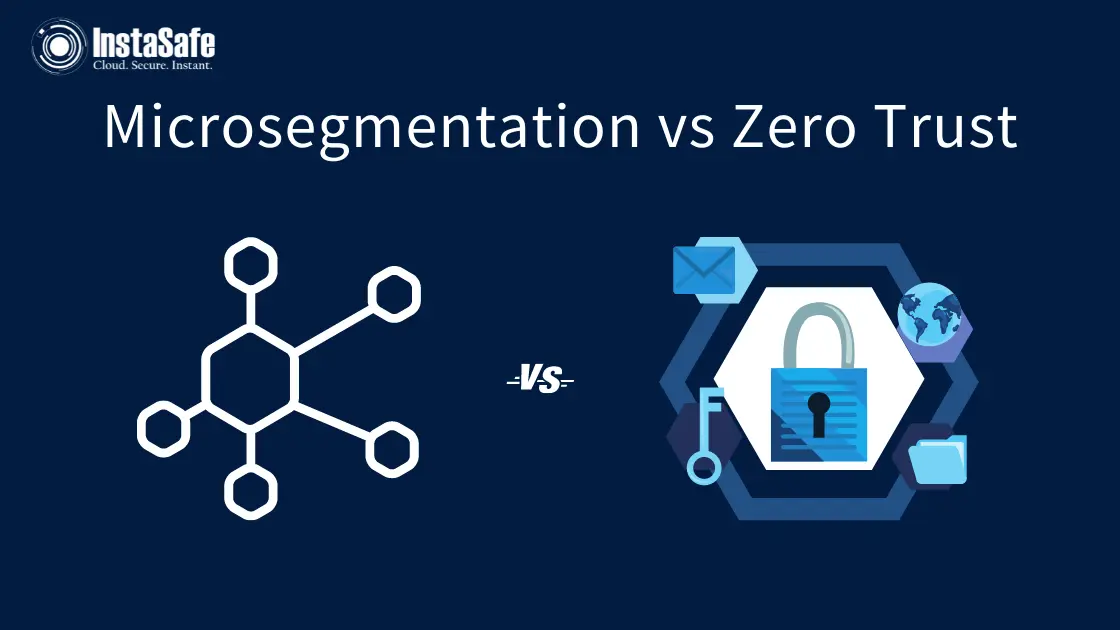Microsegmentation Vs Zero Trust

With the growing sophistication and frequency of malicious attacks, there is a dire need for approaches and tools to ensure cyber security.
Hackers use several ways to attack businesses and move freely within an organisation’s network. Furthermore, trusted users also misuse their access for malicious purposes.
Therefore, security teams must implement sophisticated techniques to stay one step ahead of cyber-attackers. For example, Zero Trust and microsegmentation are designed to reduce threats to an organisation’s network by limiting user access.
While Zero Trust is a model to secure data, microsegmentation is the architecture that helps ensure complete data protection.
Let’s learn more about microsegmentation and Zero Trust Security and how these approaches transform cyber security.
What is Microsegmentation?
Previously, organisations relied on a “flat network” that gave access to all data and applications once you were on the network. But, with the advent of network segmentation, organisations can limit the movement within a network in case of unauthorised access.
It helps protect sensitive data by limiting it to the users, servers and applications that need it for performing tasks. So, for example, users with access to a particular zone could move into that zone without restriction. But they need access to other zones after verification of identity.
Microsegmentation moves ahead and divides the network into smaller zones that go up to individual workload levels using the network virtualisation technique. By deploying security controls at each workload level, microsegmentation restricts the attacker’s ability to move inside a network in case of a breach.
Microsegmentation is not something new. Rather organisations have been using Firewalls and Virtual Local Area Networks (VLANs) to implement the microsegmentation design. However, microsegmentation doesn’t require installing multiple Firewalls.
Thus, by creating “dematerialised zones”, microsegmentation separates different networks from each other, reducing the threat of an all-out attack.
Here are some of the benefits of microsegmentation:
- Microsegmentation reduces the attack surface and limits the attacker’s reach to move laterally within the network.
- The method of microsegmentation allows security teams to monitor traffic flow. It helps prevent attackers from attempting advanced attacks across the network and contain breaches in a short time.
- Limiting the lateral spread of cyberattacks across servers, cloud instances, and virtual machines, microsegmentation safeguards an organisation’s critical assets.
- Microsegmentation allows organisations to have granular control over workloads, which helps classify data. This ensures a simplified audit process enhancing accountability in the organisation.
What is Zero Trust?
Zero Trust is a data security model that relies on the “Never Trust, Always Verify” approach to ensure network security.
John Kindervag gave the idea of Zero Trust architecture to protect the most crucial assets of an organisation. He believed traditional security architectures operate on the false assumption that every user in an organisation’s network deserves trust.
So, the model works on the assumption organisations should not trust any employee, interface or device. For the Zero Trust Model, trust is a threat to network security.
Usually, a data breach is possible due to misuse of privileged credentials. Therefore, the Zero Trust Model recognises this and tries to eliminate trust from the system.
Relying on constant evaluation of risks, the Zero Trust Model demands device verification and strict identity authentication, irrespective of the user’s location within the network perimeter.
Here are a few excellent benefits of the Zero Trust Model
- Zero Trust provides increased visibility to user activities.
- The security architecture allows maximum use of authentication.
- It restricts the attacker’s ability to move laterally within an organisation’s network.
- The Zero Trust strategy protects from internal and external threats and limits the chances of data exfiltration.
- The Zero Trust model has reduced the dependence on point solutions that limit threats. It has improved the security architecture in the cloud and on-premises.
Microsegmentation for Zero Trust Networks
- The Zero Trust Model is aimed at risk mitigation and individual access, ensuring cyber security.
On the other hand, microsegmentation provides a base to implement the Zero Trust strategy. By establishing micro perimeters around individual workloads, microsegmentation helps eliminate trust that allows attackers to move within a network.
- The Zero Trust model is based on authentication technology and individual sign-on.
Microsegmentation helps apply the strategy of Zero Trust by demanding verification and authentication on a granular scale. It is based on the core principle of “least privilege” and provides restricted access to users so that they perform their job and nothing more.
Thus, microsegmentation for Zero Trust Networks allows security teams to limit traffic across segments and isolate different segments from each other. In addition, it helps in the constant evaluation of risks and authentication of users at granular levels.
Microsegmentation vs Zero Trust
Conclusion
Thus, the strategy of Zero Trust microsegmentation allows organisations to uplift their network’s security posture and ensure the security of their critical assets.
By providing granular control over sensitive data and applications, microsegmentation Zero Trust helps organisations eliminate the principle of trust from the entire system and prevent security breaches.
So, if you want to ensure maximum security for your business network, check out our InstaSafe Zero Trust Solutions. With our Zero Trust Model, you can blacken your IT infrastructure, allow only trusted or authorised devices and ensure Zero Trust Application Access Security. Check out the prices or book a free demo today.
Key Products
Zero Trust Application Access | Zero Trust Network Access | Multi Factor Authentication | IAM Identity And Access Management | Secure Enterprise Browser
Key Features
SSO Single Sign On | Endpoint Security | Contextual Based Access Controls | Always On VPN Connection |Clientless VPN | Device Binding | Device Posture Check | Domain Joining
Key Solutions
VPN Alternative Technology | Secure Remote Access Solutions | Cloud Application Security | DevOps Security | VoIP Security Solutions
